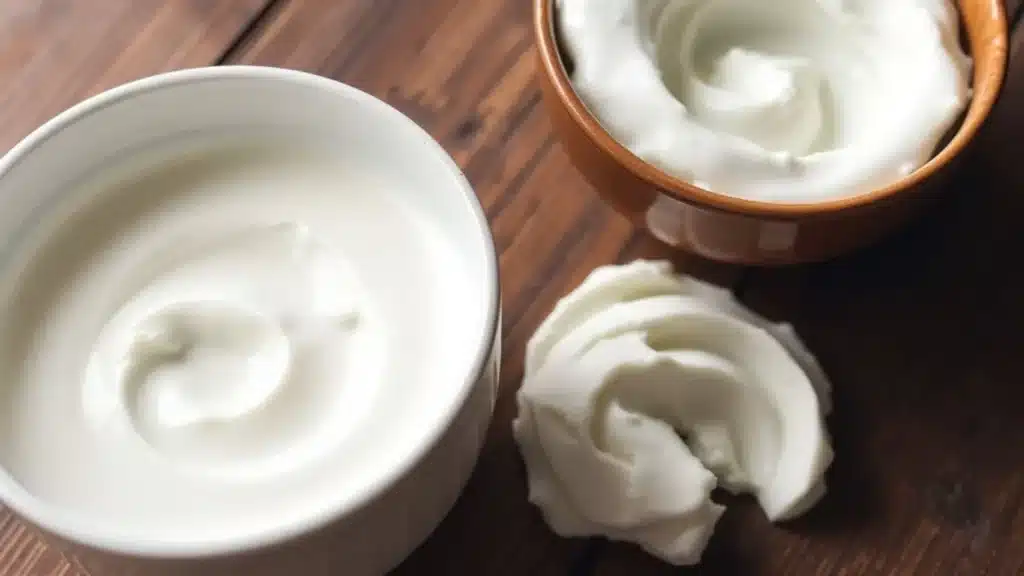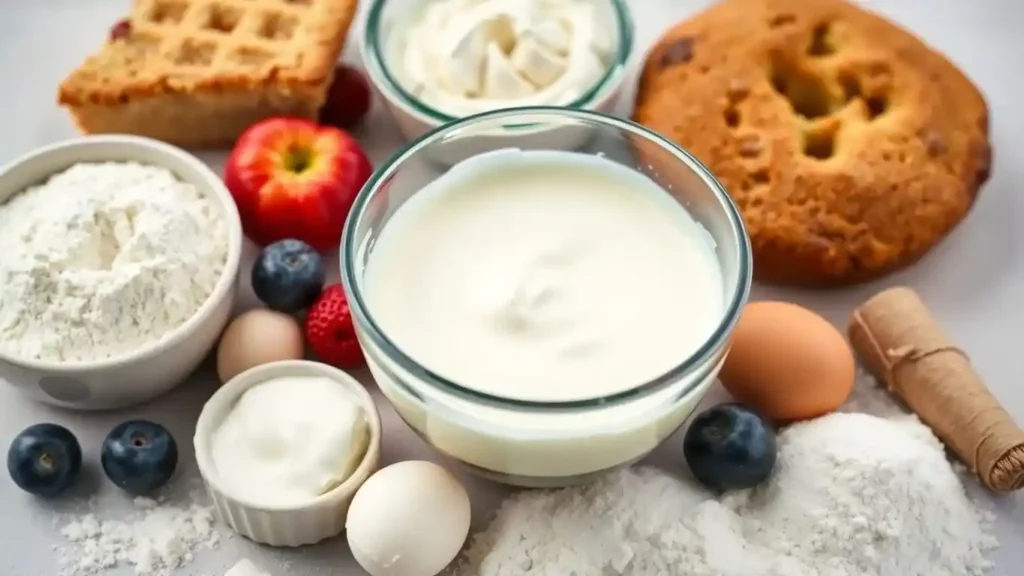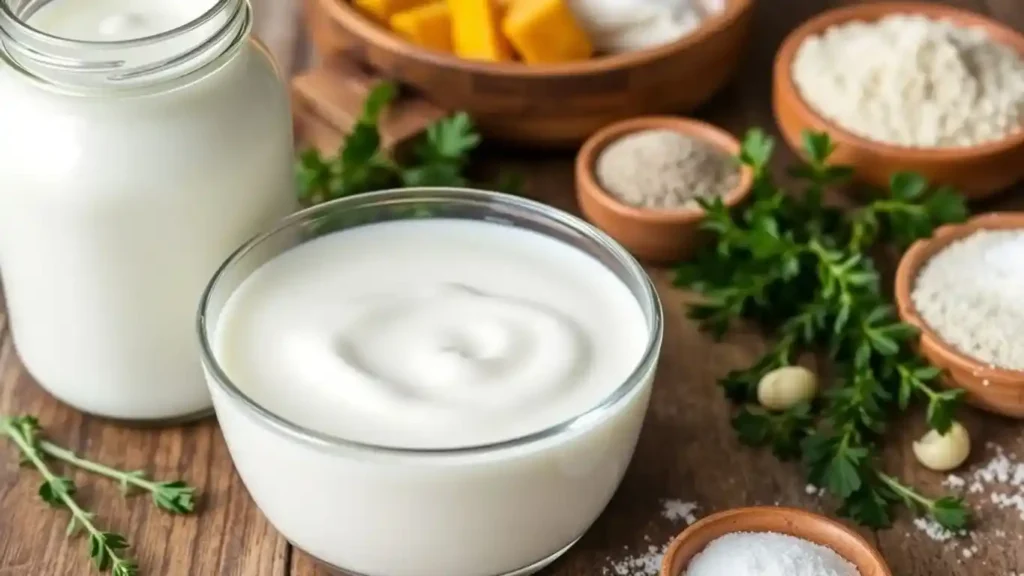Sour cream is a secret weapon in the world of baking, offering both texture and flavor enhancements to cakes, muffins, cookies, and more. Its rich fat content keeps baked goods moist, while its tangy acidity tenderizes gluten, resulting in a soft, delicate crumb. Whether you’re making a classic coffee cake or adding depth to your favorite muffin recipe, sour cream plays a crucial role in achieving bakery-quality results.
But what if you don’t have sour cream on hand? Can kefir serve as a substitute? As a fermented dairy product with a similar tangy profile, kefir offers a unique alternative but how does it compare in texture, flavor, and overall baking performance? In this article, we’ll explore the benefits of sour cream in baking, compare it with kefir, and provide practical tips on making substitutions without compromising quality.
Table of Contents
Understanding the Role of Sour Cream in Baking

Why Sour Cream is Used in Baking
Sour cream is more than just a topping for your baked potato. In baking, it plays a crucial role in enhancing texture and flavor. The acid in kefir instead of sour cream helps to tenderize gluten, which results in baked goods that are soft and fluffy. Its fat content adds richness and moisture, making your cakes and muffins taste indulgent.
For more insights into how kefir enhances baked goods, check out our detailed guide on Exploring the Benefits of Kefir in Baking.
The Texture and Flavor Impact of Sour Cream
When you add sour cream to your batter, it thickens the mixture, thanks to its creamy consistency. This thickening effect is key for achieving a dense, moist crumb in cakes and quick breads. The tangy flavor of sour cream also adds a subtle complexity to sweet treats, balancing out the sweetness without overpowering it.
Common Recipes That Use Sour Cream
Sour cream is a versatile ingredient found in numerous recipes. Here are a few popular ones:
- Cakes: Sour cream coffee cake and pound cakes often rely on sour cream to achieve a moist texture.
- Cookies: Adding sour cream to cookie dough can result in a softer, chewier cookie.
- Muffins: Sour cream muffins are known for their tender crumb and rich flavor.
Using sour cream is like adding a secret weapon to your baking arsenal. It brings moisture and a slight tang that can transform ordinary recipes into extraordinary ones.
Exploring Kefir as a Baking Substitute
Made?
Kefir is a fermented milk drink, packed with probiotics, made by adding kefir grains to milk. These grains aren’t actual grains like wheat or rice; instead, they’re a combination of lactic acid bacteria and yeasts. As the milk ferments, it develops a tangy flavor and a slightly fizzy texture. You can use dairy milk, coconut milk, or even a dairy-free milk alternative to make kefir.
Nutritional Benefits of Using Kefir
Kefir is loaded with probiotics, which are great for your gut health. It’s also rich in protein and calcium. If you’re looking for an alternative ingredient to sour cream that offers nutritional perks, kefir is a fantastic choice. Plus, it generally has a lower calorie content compared to traditional dairy products, making it a lighter option for baking.
Kefir’s Unique Flavor Profile
Curious about how kefir compares to other substitutes? Learn more about Choosing Between Buttermilk or Kefir for Your Recipes.
Kefir has a tart, tangy taste, much like yogurt but with a bit more zing. This unique flavor can add an exciting twist to your baked goods. Unlike the beany flavor some dairy-free milk options have, kefir’s taste is clean and refreshing. It’s a common ingredient in many cultures, used to enhance both sweet and savory dishes.
Kefir’s airy texture and tangy flavor make it a versatile base ingredient in baking, allowing for creativity without compromising on taste.
In baking, kefir can be a game-changer, offering a new dimension of flavor and texture. Whether you’re using a cup of milk powder or fresh milk to make it, kefir’s and health benefits make it an excellent alternative to sour cream.
Comparing Kefir and Sour Cream in Baking
Texture Differences Between Kefir and Sour Cream
Kefir and sour cream both bring their own textures to the table, but they are notably different. Sour cream is known for its thicker texture, which adds richness to baked goods. In contrast, kefir is much thinner, similar to buttermilk or heavy cream. This can affect the consistency of your batter, so adjustments might be needed to maintain the desired outcome. When using kefir instead of sour cream, you might need to reduce other liquid ingredients to prevent your batter from becoming too runny.
Flavor Variations: Kefir vs. Sour Cream
Flavor is another area where kefir and sour cream diverge. Sour cream has a mild tanginess, while kefir offers a more pronounced tang due to its higher acid content. This can enhance the flavor profile of baked goods, giving them a slight zing. However, if you’re not careful, kefir’s strong flavor might overpower more delicate recipes. Consider balancing kefir’s tang with sweet or creamy elements like fresh cream or cream cheese.
How Kefir Affects Baking Outcomes
For specific recipe adjustments using kefir, read our guide on Using Kefir Instead of Buttermilk in Cake.
Substituting kefir for sour cream in baking can lead to different outcomes. The higher acid content in kefir can react with baking soda or baking powder, potentially increasing the rise of your baked goods. This could result in a lighter, fluffier texture. However, kefir’s thinner consistency might require you to tweak the recipe to maintain structure. Experimentation is key—try starting with recipes that call for smaller amounts of sour cream to see how kefir performs before committing to larger-scale substitutions.
When swapping kefir for sour cream, keep in mind that each ingredient brings unique qualities. While kefir can offer a healthier twist with its probiotics, the change in texture and flavor might require some culinary creativity to get just right.
Practical Tips for Using Kefir Instead of Sour Cream
Adjusting Recipes for Kefir Substitution
Switching out sour cream for kefir in your recipes can be a game-changer. Kefir’s thinner consistency might mean you need to tweak your recipe a bit. If your batter seems too runny, try reducing the amount of other liquids. For instance, if a cake recipe calls for a cup of sour cream, start with three-quarters of a cup of kefir and see how it goes.
Balancing Flavors When Using Kefir
Kefir has a tangy taste, a bit like yogurt, which can add a fresh twist to your dishes. When using kefir in savory recipes, like sauces or dressings, consider adding a tablespoon of lemon juice or fresh lemon juice to enhance the tang. In sweet recipes, balance the tang by increasing the sugar slightly or adding a teaspoon of vanilla extract.
Common Mistakes to Avoid
- Ignoring Texture Differences: Remember, kefir is more liquid than sour cream. Adjust other liquids in your recipe to maintain the desired creamy texture.
- Overpowering Flavors: A bit of lemon juice can complement kefir’s tang, but too much can make your dish overly sour.
- Not Accounting for Fermentation: Kefir is a fermented product. It can react with baking soda or powder differently than sour cream. Test small batches first.
When substituting kefir for sour cream, think of it as an opportunity to experiment with flavors and textures. It’s not just about replacing an ingredient, but about discovering new taste profiles.
Kefir’s unique properties make it a versatile substitute in many recipes, offering a fresh take on traditional dishes without the need for animal-derived ingredients. Whether you’re aiming for a healthier option or simply out of sour cream, kefir can be your go-to choice.
Recipes to Try with Kefir Instead of Sour Cream
Kefir-Infused Vanilla Sponge Cake
When swapping sour cream with kefir in a vanilla sponge cake, expect a delightful twist. The tangy notes of kefir bring a refreshing balance to the cake’s sweetness. To start, mix flour, sugar, and baking powder in a bowl. In another, whisk eggs, milk kefir, and vanilla extract. Combine the mixtures, pour into a greased pan, and bake until golden. A hint of lemon zest can elevate the flavors. This cake pairs perfectly with tea or coffee, adding a light, airy texture that’s hard to resist.
Tangy Kefir Pancakes
Kefir pancakes are a fantastic breakfast option. They are fluffy, tangy, and easy to make. Begin by whisking together flour, baking soda, and a pinch of salt. In a separate bowl, mix milk kefir, eggs, and a few tablespoons of lemon juice. Combine both mixtures and let the batter sit for a few minutes. Cook on a hot griddle, flipping when bubbles form on the surface. Serve with fresh fruit or a dollop of Greek yogurt for added creaminess.
Kefir-Based Salad Dressings
Salad dressings made with kefir offer a refreshing change from traditional options. Start with a base of kefir, add olive oil, and a splash of lemon juice. Season with salt, pepper, and herbs like dill or parsley. For a creamier texture, blend in some almond milk curds or full-fat coconut milk. This dressing complements salads with baked potatoes or roasted vegetables, providing a probiotic-rich alternative to typical sour cream substitutes like cashew cream.
Health Benefits of Choosing Kefir Over Sour Cream
Probiotic Advantages of Kefir
Kefir stands out as a source of probiotics, which are beneficial for gut health. Unlike sour cream, kefir introduces a diverse range of live bacteria into your diet. These probiotics can help improve digestion, support the immune system, and may even benefit mental health by influencing brain health.
Lower Calorie Option: Kefir vs. Sour Cream
When comparing the two, kefir typically has a lower fat content than sour cream. This makes it a lighter option for those watching their calorie intake. By choosing kefir, you’re opting for a dairy product that can support weight management while still enjoying a creamy texture.
Digestive Health Benefits
Kefir is not only a source of probiotics but also a source of calcium and protein, which are essential for maintaining healthy digestion and overall health. The fermentation process in kefir breaks down lactose, making it easier to digest for those with lactose sensitivities, unlike regular yogurt or sour cream.
Opting for kefir over sour cream not only enhances your meals with a tangy flavor but also delivers a range of health benefits that support blood vessel health and overall wellness.
Incorporating kefir into your diet can be as simple as using it in smoothies, dressings, or as a substitute in recipes that call for sour cream. You can even mix it with apple cider vinegar for a unique salad dressing. This versatility allows you to enjoy the health benefits without sacrificing taste.
Creative Ways to Incorporate Kefir in Baking

Using Kefir in Sweet and Savory Dishes
Kefir is a versatile ingredient that can be used in both sweet and savory recipes. Its tangy flavor can enhance a variety of dishes, offering a unique twist. Try using kefir in place of milk or yogurt in your favorite pancake or waffle recipes for a delightful breakfast treat. On the savory side, kefir can be a great base for marinades, helping to tenderize meats while adding a subtle tang.
Enhancing Desserts with Kefir
When it comes to desserts, kefir can be a game-changer. Its creamy texture works well in cakes, providing a moist and tender crumb. Consider substituting kefir for sour cream in a classic vanilla sponge cake to achieve a light, airy cake texture. You can also mix kefir with powdered sugar and a splash of citrus juice to create a quick, tangy glaze for donuts or cookies.
Kefir as a Base for Sauces and Dressings
Kefir’s probiotic-rich profile makes it an excellent choice for sauces and dressings. Create a healthy salad dressing by mixing kefir with your favorite herbs and spices. For a creamy sauce, combine kefir with garlic and dill to serve over grilled vegetables or fish. Its acidity not only enhances flavors but also adds a nutritional boost to your meals.
Adding kefir to your recipes not only enriches the flavor but also offers health benefits, making it a valuable addition to your culinary repertoire.
Expert Opinions on Using Kefir Instead of Sour Cream

Baker’s Insights on Kefir Substitution
Bakers often find kefir a great substitute for sour cream, especially when aiming for a lighter texture in baked goods. The mild flavor of kefir doesn’t overpower other ingredients, making it versatile in various recipes. However, its tangy flavor can add an extra dimension to cakes and pastries, enhancing the overall flavor profile.
- Texture: Kefir’s consistency is thinner than sour cream, which might require recipe adjustments.
- Flavor: Its tangy flavor can complement sweet dishes, providing an extra flavor kick.
- Moisture: Kefir adds moisture, which can be beneficial for dry batters.
Nutritionist’s Perspective on Kefir
From a health standpoint, kefir is a winner. It’s packed with probiotics, which are great for gut health. Plus, it’s generally lower in calories than sour cream, making it a healthier choice without sacrificing flavor.
- Probiotics: Supports digestive health and boosts the immune system.
- Calories: Offers a lower-calorie alternative to sour cream.
- Nutrients: Provides essential vitamins and minerals.
“Kefir not only aids digestion but also supports overall wellness with its nutritional benefits.”
Chef’s Tips for Cooking with Kefir
Chefs appreciate the versatility of kefir in the kitchen. Its tangy flavor can replace sour cream in both sweet and savory dishes, offering a unique twist. When substituting, consider adding extra lemon juice to balance the flavors, especially in recipes that require a more pronounced tang.
- Savory Dishes: Works well in sauces and dressings.
- Sweet Dishes: Enhances desserts with its subtle tang.
- Flavor Balance: Adjust with extra lemon juice if needed for more tang.
Conclusion
So, can you swap kefir for sour cream in your baking adventures? Absolutely! While kefir is a bit runnier, it brings a unique tang and moisture to your baked goods. Just remember to adjust the liquid in your recipe a bit to keep the balance right. Whether you’re whipping up a cake or some muffins, kefir can be a fun twist. Plus, it’s packed with probiotics, so you’re not just baking, you’re adding a little health boost too. Give it a try next time you’re in the kitchen and see how it changes things up!
Frequently Asked Questions
Can I use kefir instead of sour cream in cakes?
Yes, you can use kefir instead of sour cream in cakes. It gives a tangy taste and keeps the cake moist. Just remember, kefir is runnier, so you might need to adjust the liquid ingredients.
How does kefir affect the flavor of baked goods?
Kefir adds a tangy and slightly sour taste to baked goods. It can enhance the overall flavor, making it a bit more complex and interesting.
Is kefir healthier than sour cream?
Kefir is generally considered healthier than sour cream because it contains probiotics, which are good for your gut. It’s also usually lower in fat and calories.
What is the best way to substitute kefir for sour cream in recipes?
To substitute kefir for sour cream, use the same amount of kefir as you would sour cream. You might need to reduce other liquids in the recipe since kefir is thinner.
Can I use kefir in savory dishes instead of sour cream?
Yes, kefir can be used in savory dishes like soups and sauces. It adds a tangy flavor and can help thicken the dish slightly.
Does kefir change the texture of baked items?
Kefir can make baked items softer and more tender. Because it’s thinner than sour cream, it may also make the batter a bit runnier, so adjust as needed.
